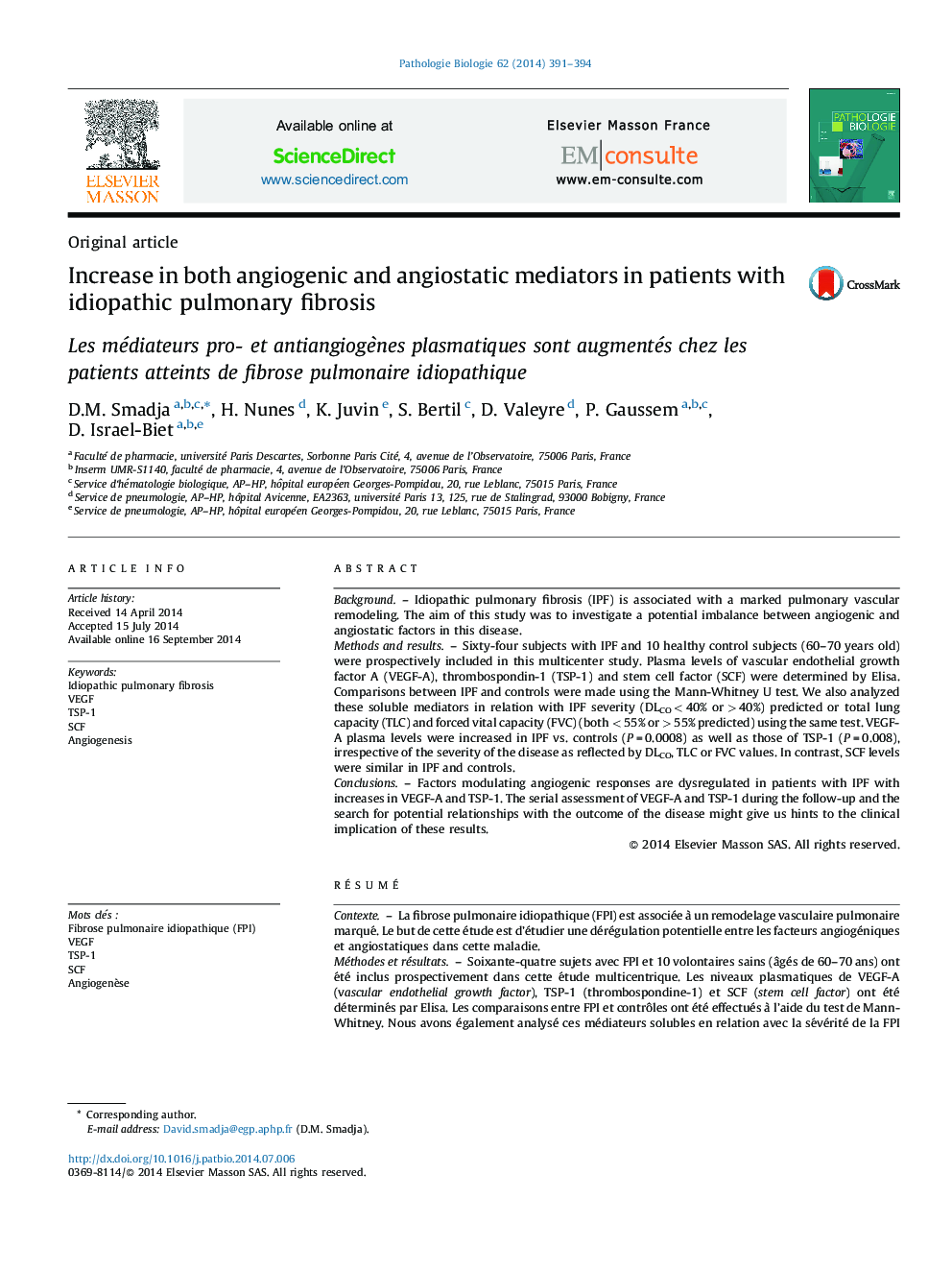| کد مقاله | کد نشریه | سال انتشار | مقاله انگلیسی | نسخه تمام متن |
|---|---|---|---|---|
| 4136042 | 1271892 | 2014 | 4 صفحه PDF | دانلود رایگان |

BackgroundIdiopathic pulmonary fibrosis (IPF) is associated with a marked pulmonary vascular remodeling. The aim of this study was to investigate a potential imbalance between angiogenic and angiostatic factors in this disease.Methods and resultsSixty-four subjects with IPF and 10 healthy control subjects (60–70 years old) were prospectively included in this multicenter study. Plasma levels of vascular endothelial growth factor A (VEGF-A), thrombospondin-1 (TSP-1) and stem cell factor (SCF) were determined by Elisa. Comparisons between IPF and controls were made using the Mann-Whitney U test. We also analyzed these soluble mediators in relation with IPF severity (DLCO < 40% or > 40%) predicted or total lung capacity (TLC) and forced vital capacity (FVC) (both < 55% or > 55% predicted) using the same test. VEGF-A plasma levels were increased in IPF vs. controls (P = 0.0008) as well as those of TSP-1 (P = 0.008), irrespective of the severity of the disease as reflected by DLCO, TLC or FVC values. In contrast, SCF levels were similar in IPF and controls.ConclusionsFactors modulating angiogenic responses are dysregulated in patients with IPF with increases in VEGF-A and TSP-1. The serial assessment of VEGF-A and TSP-1 during the follow-up and the search for potential relationships with the outcome of the disease might give us hints to the clinical implication of these results.
RésuméContexteLa fibrose pulmonaire idiopathique (FPI) est associée à un remodelage vasculaire pulmonaire marqué. Le but de cette étude est d’étudier une dérégulation potentielle entre les facteurs angiogéniques et angiostatiques dans cette maladie.Méthodes et résultatsSoixante-quatre sujets avec FPI et 10 volontaires sains (âgés de 60–70 ans) ont été inclus prospectivement dans cette étude multicentrique. Les niveaux plasmatiques de VEGF-A (vascular endothelial growth factor), TSP-1 (thrombospondine-1) et SCF (stem cell factor) ont été déterminés par Elisa. Les comparaisons entre FPI et contrôles ont été effectués à l’aide du test de Mann-Whitney. Nous avons également analysé ces médiateurs solubles en relation avec la sévérité de la FPI reflétée par la DLCO (< 40 % ou > 40 % des valeurs prédites), ou encore la TLC et la FCV (<55 % ou > 55 %). Les taux plasmatiques de VEGF-A et de TSP-1 sont augmentés chez les FPI (p = 0,0008 et p = 0,008, respectivement, pour le VEGF-A et la TSP-1), indépendamment de la sévérité de la maladie.ConclusionsLes facteurs de croissance modulant les réponses angiogènes sont dérégulées chez les patients atteints de FPI avec une augmentation du VEGF-A et de la TSP-1. L’évolution de leurs taux au cours de l’évolution de la maladie et de son issue pourrait nous donner une indication sur la signification clinique de cette dérégulation.
Journal: Pathologie Biologie - Volume 62, Issue 6, December 2014, Pages 391–394